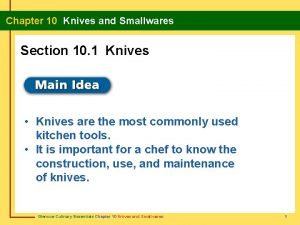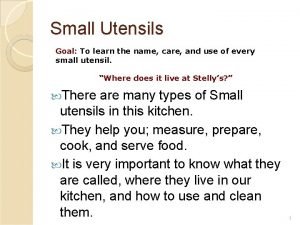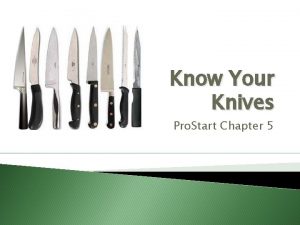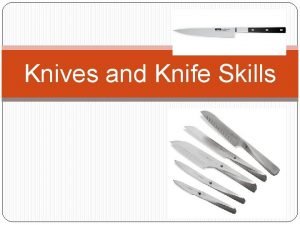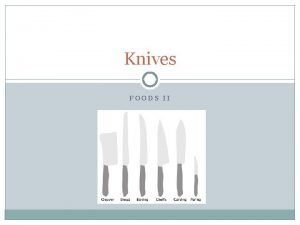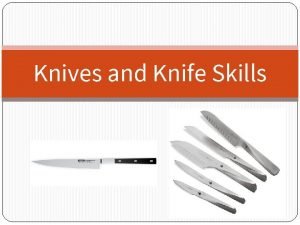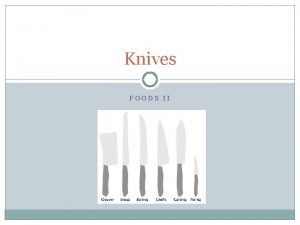The use of knives in Catering Identify the










- Slides: 10

The use of knives in Catering

Identify the following knives: • • • Bread knife Palette knife Carving knife Cook's knife Boning knife Paring knife Meat cleaver Filleting knife Cheese knife Vegetable peeler

Types of knives • It's important to know how to choose the right knife for the task at hand. If you use a knife that's too large for the job, you won't have enough control and are more likely to slip and have an accident. These are the basic knives for the most common kitchen tasks: • Bread knife: this is similar to a carving knife, with a serrated edge. Uses include: slicing loaves. • Palette knife: either plain-edged or serrated. The blade is always flexible and rounded at the top. Uses include: icing cakes and pastries; turning food over during cooking (such as fish fillets or fritters); moulding and smoothing food. • Carving knife: also known as meat knives or slicers, these have long blades with a serrated or plain edge and can be rounded or pointed. Uses include: carving whole hams, slicing smoked salmon. • Cook's knives: these come in different sizes and their strong, rigid blades make them suitable for a wide range of jobs. Uses include: dicing, chopping and trimming vegetables, meat and poultry; chopping fresh herbs. • Boning knife: these have very strong blades that will not bend or break easily. They can be straight or curved to suit small and large butchery. Uses include: removing bones from meat joints and poultry. • Paring knife: this is a small knife and has a thin and slightly flexible blade, making it ideal for hand-held work. Uses include: shaping mushrooms, turning carrots. • Meat cleaver: large, square blade used for butchery. • Filleting knives: these thin-bladed, flexible and very sharp knives can vary in length. Uses: filleting fish. • Most cooks will be able to get by with just three knives for all but the most specialist jobs, such as filleting a fish. A multi-purpose, heavy cook's knife, a small cook's knife and a serrated bread knife are the ones to go for. You can add to your knife collection over the years

Cleaning knives • Keep knife handles free of grease to prevent your hand from slipping, and wash knives thoroughly between uses. • Clean your knives with hot water and detergent, ensuring you wash both the blade and the handle (ensure the sharp edge is facing away from the body and take great care to keep your fingers away from the sharp edge of the blade). Rinse with very hot water to kill any remaining bacteria and dry thoroughly with a disposable paper towel. • Knives should NEVER be left to soak in a sink because someone could put their hands in the water without seeing the knife and cut their hand or arm badly.

Sharpening knives • Knives must always be kept sharp. A blunt knife is dangerous because it requires more pressure and is more likely to slip and cause a cut. This is the most important reason to keep your knives sharp. • A sharp knife also means a better, faster and easier job. It will also enable you to work neatly and accurately. • If you know how, then you can sharpen your own knives (little and often is best) using a grinder or steel. • After sharpening, always clean your knife to remove any filings that might be on the blade. The safest way to test for sharpness is to cut a soft tomato - a sharp knife will slice through easily and with little pressure. • A professional chef should sharpen his or her knives every time they are used. • After a long while you may find you won't be able to sharpen your knife with a steel because the edge will get too thick. This is when you'll need to have it professionally re-ground. There are companies that specialise in knife grinding or ask your local cook shop or butchers if they have a grinder on the premises.

Knife safety • Ensure you've got a secure cutting surface. You can easily slip and cut yourself if the board moves suddenly. Placing a damp cloth under the board will give it a good grip. Heavy, solid boards are also less likely to move or wobble. • When not using a knife, place it flat on the work surface with the sharp edge of the blade facing the board - never leave the knife standing up with the blade pointing upwards. Don't leave knives near or hanging over the edge of a surface where they could be knocked. If you do knock a knife then don't try to catch it as it falls because it could easily slice through your hand sever a main artery. If you drop a knife, then move out of the way and allow it to fall. • Take care to keep your knife in sight and never allow it to get hidden under anything, especially food items. This can often occur when piles of vegetable trimmings accumulate or there’s a lot of clutter on the work surface. • If you have to carry a knife then carry it at some distance from the body with the point facing down and the sharp edge facing backwards. Never carry a knife with the point facing forwards and never carry knives on chopping boards (this is often done when carrying dirty boards and knives to the sink and is a dangerous short-cut).

Storing your knives Store your knives in a purpose-made case, a carrying wallet, a knife block or on a magnetic rack. Never throw your knives into a drawer or box. They should be stored so that they are easy to find without having to search through a pile of cutlery. • For the home kitchen use a knife block or a magnetic wall rack to store your knives. If you have to keep them in a drawer, then make sure they are separated from each other so that the blades don't rub and become blunt. • Never store a knife on a high shelf where someone might not be able to see it. Someone could reach up for something else and knock the knife off or grab it while feeling for something else.

Video clips • 1 • http: //www. bbc. co. uk/food/get_cooking/techniques/000004. shtml • 2 • http: //www. bbc. co. uk/food/get_cooking/techniques/000005. shtml • 3 • http: //www. bbc. co. uk/food/get_cooking/techniques/000006. shtml • 4 • http: //www. bbc. co. uk/food/get_cooking/techniques/000007. shtml

The following cutting terms often appear in recipe books: • Macedoine = 5 mm dice • Jardiniere = 4 mm x 1. 5 cm pieces • Paysanne = even, thin pieces cut as triangular, round or square with a 1 cm diameter • Brunoise = 3 mm dice • Julienne = matchsticks • Chiffonade = finely shredded ingredients (such as lettuce or cabbage)

Risk Assessment for using sharp knives in the kitchen • The following rules should be observed when handling a knife: • Use the right knife for the right job, e. g. , a cook’s knife for chopping, a fish filleting knife for filleting fish. • Knives must always be sharp and clean • Handles should be free from grease • The point must be held downwards • Knives should always be placed flat on the table or board, so that the blade is not exposed upwards • Knives should be wiped clean with the edge away from the hand • Do not put knives in washing up bowl – someone may put their hands in • Always carry the knife, with point facing down, parallel to your body.

